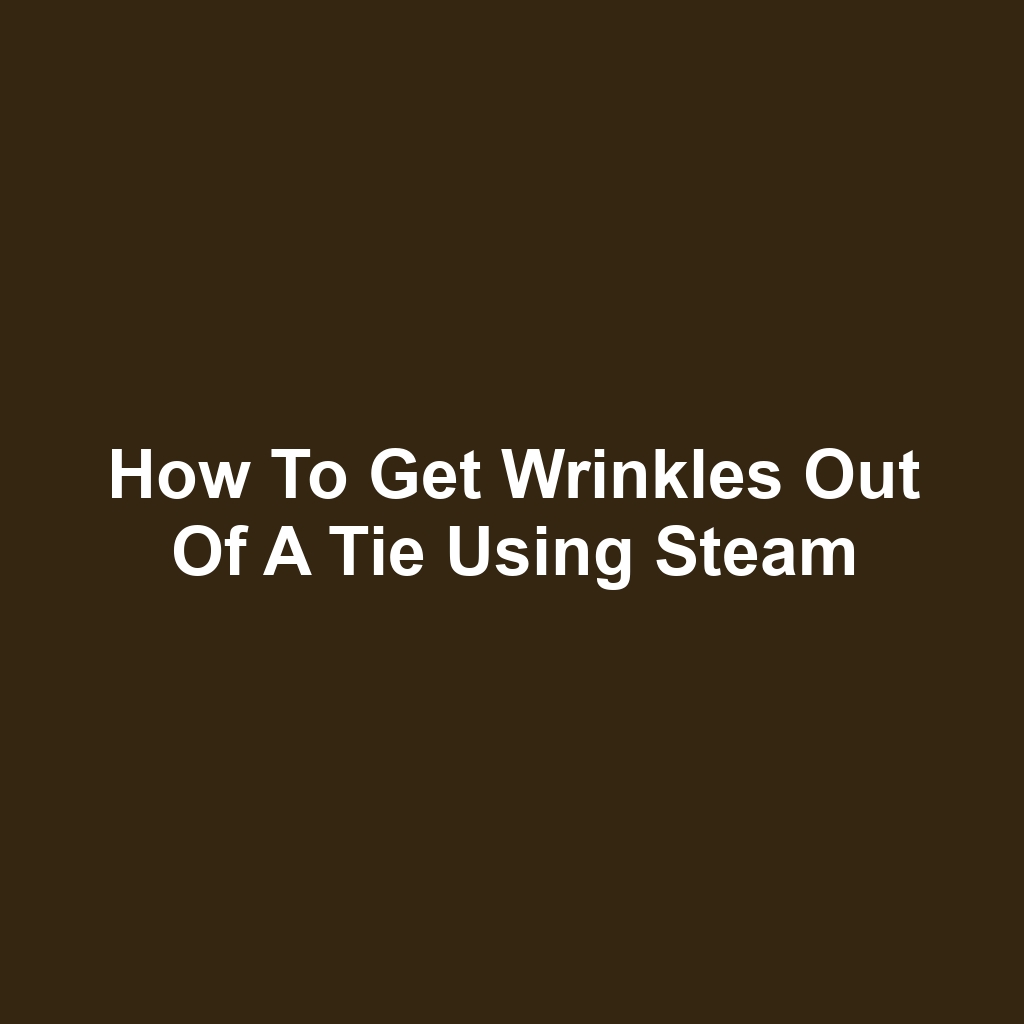Maintaining a polished appearance often hinges on the details, and a well-pressed tie is a crucial element of professional attire. However, ties can become wrinkled during storage or travel, leading to an unkempt look. This article will guide you on how to get wrinkles out of a tie using steam, a gentle yet effective method for restoring its original form. We will explore various steaming techniques, preparation steps, and maintenance tips to ensure the longevity and quality of your tie. By following these guidelines, you will be equipped to present yourself with confidence and style.
Choosing the Right Steaming Method
The selection of an appropriate steaming method is crucial for effectively removing wrinkles from a tie without causing damage to the fabric. Various steaming techniques exist, each suited to different types of fabrics and ties. A handheld steamer, for instance, offers portability and ease of use, making it a popular choice among professionals and home users alike. On the other hand, a traditional steam iron can provide more controlled pressure, allowing for precise wrinkle removal.
It is essential to consider the fabric content of the tie, as delicate materials such as silk require gentler steaming methods. The distance between the steamer and the fabric should be maintained to prevent overheating or scorching. Additionally, using a pressing cloth can provide an extra layer of protection against direct steam exposure. The steam should be applied evenly, starting from the top of the tie and moving downward. Ultimately, selecting the right steaming method ensures a wrinkle-free finish while preserving the integrity of the tie’s fabric.
Preparing Your Tie for Steaming
Preparing your tie for steaming involves ensuring it is clean and free of any stains that could be exacerbated by moisture. Begin by inspecting the tie for any visible marks or blemishes. If necessary, gently spot-clean the fabric with a suitable cleaner, taking care not to saturate the material. Allow the tie to dry completely before proceeding with the steaming process. Next, check the fabric content of the tie to confirm that it is steam-safe. Certain materials, such as silk, may require a more delicate approach. Lay the tie flat on a clean surface to minimize creasing during the steaming process. Ensure that the tie is positioned in a way that allows easy access for the steam. Once prepared, you can confidently move on to the steaming method of your choice.
Applying Steam to Remove Wrinkles
Applying steam effectively relaxes the fibers of the tie, allowing wrinkles to diminish with minimal effort. To begin the steaming process, it is essential to hold the iron or steamer at a safe distance from the fabric to prevent damage. A distance of approximately six inches is generally recommended for optimal results. It is advisable to move the steamer in a gentle, downward motion, ensuring even coverage across the tie’s surface. Focus on the areas with the most pronounced wrinkles, applying steam briefly to these sections.
After steaming, it is beneficial to allow the tie to hang for a few minutes, letting the fibers settle into their newly smoothed position. Utilizing a hanger or tie rack during this period can help maintain the tie’s shape. In cases of stubborn wrinkles, a second round of steaming may be necessary for effective results. Finally, it is important to store the tie properly after steaming to preserve its appearance and prevent future wrinkles.
Tips for Maintaining Tie Quality
Regular care and attention to fabric quality can significantly extend the lifespan of a tie while preserving its appearance. Proper storage is essential; ties should be hung or rolled to maintain their shape and prevent creasing. Avoid exposing ties to direct sunlight, which can lead to fading and deterioration of color. Cleaning should be done with caution; dry cleaning is often recommended for delicate fabrics. If washing at home, use cold water and a gentle detergent to avoid damage. Regularly check for loose threads and promptly address any issues to prevent further wear. Rotate ties to ensure even use, allowing each one to rest and recover from wear. Consider investing in a fabric spray to refresh ties between cleanings, maintaining their subtle fragrance and appearance. By implementing these practices, the longevity and aesthetic quality of ties can be greatly enhanced.
Storing Your Tie After Steaming
Proper storage of a tie after steaming is essential to preserve its shape and prevent new wrinkles from forming. It is advisable to hang the tie on a quality tie hanger to maintain its structure. Alternatively, rolling the tie gently can also be an effective method for storage. Ensure that the tie is placed in a cool, dry environment away from direct sunlight, as excessive heat can damage the fabric. Using a breathable fabric bag can protect the tie from dust and moisture. Avoid folding the tie, as this can create creases that are difficult to remove. Regularly checking the tie for any signs of wear or damage will help maintain its condition. Additionally, storing the tie in a drawer lined with soft materials can prevent friction with other items. A well-stored tie not only looks better but also lasts longer.
Conclusion
In conclusion, effective wrinkle removal from a tie can be accomplished through careful application of steam, taking into account the specific fabric type and proper steaming techniques. The importance of inspecting the tie for stains and ensuring appropriate cleaning methods cannot be overstated, particularly when dealing with delicate materials. Proper storage practices, such as hanging or rolling ties, play a crucial role in preserving their shape and preventing future creasing. Regular maintenance, including checks for wear and damage, contributes significantly to the longevity of ties. Ultimately, following these guidelines enhances both the appearance and durability of this essential accessory.
If you’re looking to make a difference in your community and need assistance finding hotel vouchers for the homeless in Tennessee, I highly recommend visiting this resourceful page. It provides valuable information and guidance on how to access support services effectively. Check it out here!
